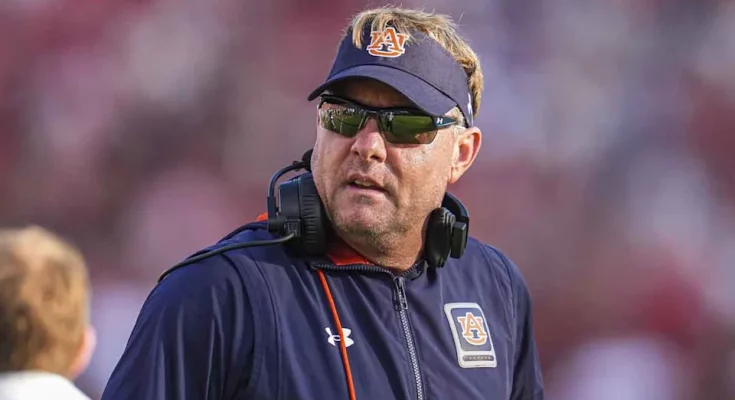Auburn football has long been known for its deep traditions, loyal fan base, and the sense of family that permeates everything surrounding the program. From the soaring echoes of “War Eagle” before every game to the cherished memories at Jordan-Hare Stadium, Auburn is a brand that extends far beyond the field. However, in today’s college football landscape, tradition alone cannot carry a program to the heights needed to compete in an ever-changing environment. The dynamics of college sports are shifting rapidly, fueled by television contracts, name, image, and likeness (NIL) deals, and the growing commercialization of athletics. Against this backdrop, Auburn football’s recent decision to make a big move with on-field sponsorship represents a pivotal moment that speaks volumes about where the sport is headed and how Auburn plans to stay ahead of the curve.
On-field sponsorship has always been a sensitive topic in college football. For decades, college programs were resistant to overt commercialization of the game itself, opting to preserve the image of purity and tradition. While corporate sponsorships existed in the form of stadium naming rights, uniform suppliers, or official partnerships, the sacred space of the playing field remained largely untouched. The green grass, white yard lines, and end zones painted in team colors symbolized something that was uniquely “college football.” But as television rights fees ballooned, NIL changed the business model, and athletic departments faced mounting costs, universities began reconsidering how to maximize revenue streams without alienating their core supporters. Auburn’s decision to introduce on-field sponsorship is a reflection of this larger shift, and it is a calculated move designed to strengthen the program both financially and competitively.
For Auburn, this move is not just about money, though the financial implications are massive. On-field sponsorships provide an additional revenue source that can bolster recruiting, facilities, staff salaries, and even the overall athletic department budget. In the era of the SEC arms race, where programs like Alabama, Georgia, and LSU constantly pour resources into keeping their programs at the top, Auburn cannot afford to lag behind. Every dollar matters when it comes to competing at the highest level, and revenue from sponsorships will allow Auburn to make investments that keep them in contention for conference titles and College Football Playoff appearances. A major brand displayed prominently during Auburn’s nationally televised games means not only a direct infusion of cash but also the kind of exposure that attracts other business partners. It creates a cycle where success on the field and visibility off it reinforce one another.
From a business standpoint, this is Auburn signaling to corporate America that they are open for collaboration at the highest levels. On-field sponsorship space is premium real estate, given the sheer number of eyeballs watching SEC football every Saturday. Auburn’s games regularly draw millions of viewers, both in the stadium and on television. For companies, the chance to have their logo displayed in conjunction with a powerhouse brand like Auburn football represents an unparalleled marketing opportunity. For Auburn, it positions the program as a modern, forward-thinking operation that understands the realities of today’s sports economy.
The fan response, however, is where the challenge lies. Auburn’s faithful fan base is fiercely protective of the traditions that define the program. For many, the thought of logos intruding onto the playing surface feels like a departure from the purity of the game. College football, after all, has always been about more than just the product on the field; it is about pageantry, community, and loyalty. Auburn officials have had to balance the desire for revenue with the need to respect those traditions. The rollout of this on-field sponsorship was done carefully, emphasizing that the integrity of the game will not be compromised. By ensuring that the logos or sponsorship marks are placed in a tasteful, non-distracting way, Auburn has sought to ease concerns while still making a bold step into the future.
There is also the broader context of NIL, which cannot be separated from this decision. College football players now have unprecedented opportunities to profit off their personal brands, and programs are constantly searching for ways to provide resources that make their schools more attractive destinations. Revenue from on-field sponsorship can directly and indirectly support NIL collectives, ensuring Auburn remains competitive when pursuing top recruits. In essence, sponsorship deals help fund the ecosystem that keeps players happy, recruits interested, and fans engaged. Auburn knows that if they are going to keep pace with programs like Alabama, Texas, and Georgia, they need to find every possible advantage, and this is one of them.
This decision also sends a message about Auburn’s long-term vision for athletics. It is no longer enough to be reactive in college football; programs must anticipate future changes and position themselves accordingly. Auburn is choosing to be proactive, embracing commercialization in a way that is strategic rather than desperate. By being among the earlier adopters of on-field sponsorship in a major way, Auburn establishes itself as a leader rather than a follower. When the rest of the SEC inevitably follows suit, Auburn will already have built strong partnerships and refined the process. This move will be remembered as part of Auburn’s transition into the modern era of college football business.
Historically, Auburn has always had to balance tradition with innovation. The university’s football program carries the weight of legends—Bo Jackson, Pat Sullivan, Cam Newton—and with that history comes an obligation to maintain a certain standard. At the same time, Auburn cannot ignore the shifting realities of college athletics. The decision to incorporate on-field sponsorship is the latest example of Auburn threading that needle. Just as the university once expanded its facilities, invested in recruiting strategies, and adapted to new television contracts, it is now adapting to the commercialization of the field itself. Each move is part of a larger story about survival, growth, and relevance in the SEC.
From the perspective of Auburn’s rivals, this move also changes the perception of the program. Recruiting battles in the SEC are not just about coaches, facilities, and wins; they are about perception and brand strength. By aligning with major corporate sponsors on the field, Auburn demonstrates that it is not only a football power but also a business powerhouse. High school recruits and their families notice these details. They want to join programs that feel “big time,” and on-field sponsorship helps Auburn project that image. The financial windfall also means Auburn can continue to upgrade training facilities, provide state-of-the-art nutrition and recovery programs, and pay for the kind of coaching talent that draws players in. Every edge matters, and this move gives Auburn another one.
Of course, there are critics who argue that this commercialization represents a slippery slope. Once the sanctity of the field is breached by logos and advertisements, where does it stop? Will college football one day resemble European soccer, where jerseys and stadiums are covered with sponsorships to the point where the team identity is blurred? Auburn officials have had to address these concerns, assuring fans that the move will be limited in scope and designed to complement, not overshadow, Auburn traditions. It is a delicate balance, but one that Auburn believes it can manage.
The move also aligns with broader trends across the NCAA. With revenue distribution becoming increasingly contentious, especially with playoff expansion and debates about athlete compensation, athletic departments are under pressure to find new ways to generate income. Auburn is not alone in this, but it is among the programs willing to step forward and experiment. If successful, Auburn could set a precedent for other schools, especially within the SEC, to follow. In time, on-field sponsorship could become as normal as stadium naming rights or bowl game sponsorships. Auburn is betting that fans will ultimately accept the change, especially if it translates to wins on the field.
For the Auburn community, the real test will be in how this move impacts the program’s trajectory. If on-field sponsorship translates into more competitive teams, better recruits, and greater national relevance, fans will likely embrace it as a necessary evolution. Auburn’s identity has always been tied to its ability to fight and compete at the highest levels despite often being overshadowed by rivals like Alabama. This move, then, is not just about dollars and cents—it is about pride, ambition, and the determination to make Auburn football a perennial contender in the modern landscape.
The importance of timing cannot be understated either. College football is entering an era of realignment, playoff expansion, and heightened competition. Programs that fail to innovate risk being left behind, while those that seize opportunities can set themselves apart for the next decade. Auburn’s big move with on-field sponsorship is as much about tomorrow as it is about today. It is a sign to recruits, fans, and rivals alike that Auburn intends to compete on every level—financially, athletically, and culturally.
In the end, Auburn football’s decision to embrace on-field sponsorship reflects the broader evolution of college athletics. Tradition is still valued, but survival and success now require financial ingenuity and business acumen. Auburn is positioning itself to thrive in this new reality, balancing respect for its heritage with a clear-eyed understanding of the future. While some fans may hesitate to accept this change, history suggests that Auburn’s community is resilient and adaptable. If the move helps Auburn win more games, land bigger recruits, and secure its place among the elite of college football, then the gamble will have been worth it.
The roar of the crowd at Jordan-Hare Stadium will remain, the chants of “War Eagle” will echo just as they always have, and the program’s traditions will endure. But alongside those traditions will now be a new layer of modernity, a recognition that Auburn football is not just part of history but also part of a rapidly changing present. The decision to incorporate on-field sponsorship is Auburn’s way of declaring that it intends to compete in every arena, not just between the white lines but in the business world that increasingly defines college sports. It is bold, it is timely, and it could very well be remembered as one of the key steps that allowed Auburn to thrive in the modern era of football.



